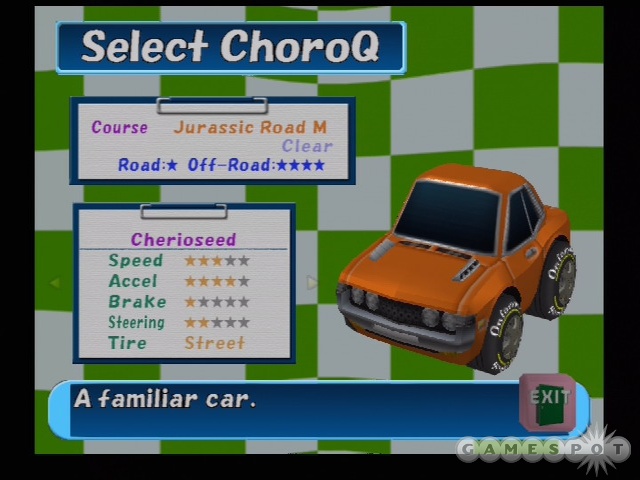Though ChoroQ may seem like an arbitrarily peculiar Japanese racing game to American eyes, in Japan this series has served as a digital extension of the superdeformed ChoroQ toy cars, and both the toy cars and the racing series have enjoyed great popularity in that country for many years. However, if you don't already have an established love for Takara's customizable line of toy cars, you'll find that ChoroQ has little in the way of redeeming qualities.

Outside of the license, ChoroQ's biggest selling point is that it combines racing with RPG elements. You play as a young ChoroQ (not the driver, mind you, but the actual car) who is entering the world of racing. There is a story of sorts, with the eventuality of you becoming the great people's champion apparent from the very start. To climb the ladder you'll need to run a series of races, join a racing team, and perform other driving-related tasks. Winning races can earn you different "bodies" for your ChoroQ (though these are largely aesthetic improvements), as well as cash that can go toward purchasing performance-oriented upgrades.
The upgrade system is the most fully realized aspect of ChoroQ, allowing for a high level of customization. You can purchase everything from a new chassis to an onboard computer, and most of the parts you purchase will have an effect on your performance. Most performance upgrades will help you on the track under any conditions, though there are certain parts that are conditional. There are some tires, for example, that will provide a great performance edge on paved courses, but not so much on dirt tracks. There are also many upgrades that are just bells and whistles--or, more accurately, horns and radios. This feature mirrors the customization that is inherent to the actual ChoroQ toy cars, but in the wake of games like Need for Speed Underground, the level of customization offered here isn't so unique, and it's not enough to compensate for the game's other shortcomings.
Though tweaking your funny-looking little car can be fun, the actual races you have to endure to do it are not. At the start of the game, your ChoroQ is extremely slow, and without liberal application of the brakes when rounding corners, you'll often spin out. The pacing is extremely arduous, almost like that of a hardcore racing simulation, but without the precision or depth. The speed and the handling gradually get better as you progress, but at no point does the racing become particularly fun. The collision detection also feels a bit haphazard, and cars will bounce around oddly when they make contact with each other. Winning races and making real progress is hard (you'll find yourself entering the same races repeatedly to win enough third- or fourth-place prizes to afford another piece of performance-enhancing equipment), and it becomes a total grind really quickly. Considering the otherwise lighthearted, easygoing tone of the game, the dry and unforgiving racing mechanics seem extremely out of place, and the game would have been far more likable if it had been more fast and loose with the racing.

From a technical perspective, ChoroQ looks about as bad as it plays, but, to its credit, it at least stays true to its playful origins. All the cars are stocky and squat versions of real-life cars, just like the toys they're based on, and while they're a little blocky, they get the point across. The game trades largely in bright primary colors, and there seems to be little in the way of consistency when it comes to the track designs--one minute you'll be racing on a straightforward NASCAR-style oval track, and the next you'll be weaving through toys in what appears to be a child's bedroom. The game doesn't do particularly well with actual curved lines, and everything has a stiff, angular look to it, accompanied by very simplistic and low-res textures. Frankly, the game doesn't look that much better than its predecessors on the original PlayStation. The game's sound follows suit, with the sort of bad synthesized lounge music that you might hear in a horse-racing simulation or mahjong game, accompanied by some dull engine drones and bland tire squeals.
Without the context provided by the line of toy cars to fall back on in the US, ChoroQ comes across as a quirky, cutesy racing game with poor graphics and even poorer racing mechanics. The purported RPG elements do at least provide a somewhat unique structure for the game, but they don't add a lot of appreciable depth to the experience. The racing genre has evolved in some significant ways over the past few years, but ChoroQ seems like it's just been spinning its wheels.